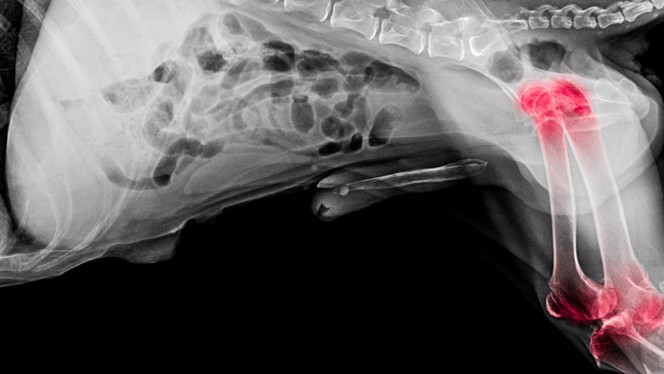Six tips for coping with arthritis in dogs: A vet's guide
Arthritis in dogs is a common condition that can change your dog’s life. Learn how to cope with these strategies

Arthritis in dogs is not uncommon. Is your senior dog starting to slow down? It may be something more serious than just getting older. Arthritis – also sometimes called osteoarthritis or degenerative joint disease – is a common condition in dogs, particularly seniors.
In dogs with arthritis, the normal cartilage cushion surrounding a joint begins to break down, causing damage and inflammation of the joint. This leads to gradually worsening pain, stiffness and loss of mobility.
Estimates of the prevalence of arthritis in dogs vary, but some studies have indicated that 6.6% to 20% of dogs in the UK are affected, and as many as 80% of dogs over the age of eight in the United States may be affected. The good news is that if your dog has been diagnosed with arthritis, there are six effective steps you can take to help.
1. Pain control is your dog’s new best friend
Arthritis in dogs is a painful and progressive condition, but it can be managed with a good multimodal pain control regimen. The first step is to visit your veterinarian to have your dog’s arthritis diagnosed and evaluated.
Your veterinarian will also likely have a discussion with you regarding your dog’s level of pain and current quality of life. From there, your vet will be able to recommend the best pain control regimen to suit your dog’s needs.
Some dogs only need to take pain medications intermittently, to cope with particularly bad days, while others may need to take medications daily to maintain a good quality of life. Because arthritis is a progressive condition, it is important to monitor your dog’s pain and mobility frequently, and to follow up with your veterinarian regularly so medications can be adjusted to suit your dog’s needs.
2. Joint supplements may help arthritis in dogs – start them early!
Joint supplements are often used for arthritis in dogs because they can slow the progression of joint damage and improve mobility. While products vary in their ingredients, most have two supplements in common: glucosamine and chondroitin.
Get the best advice, tips and top tech for your beloved Pets
Glucosamine and chondroitin have long been used for the management of arthritis in dogs as well as humans. These supplements can help reduce inflammation in the joints, increase lubrication and slow the progression of joint damage.
There are a variety of joint supplements available that are specifically formulated for dogs. Ask your veterinarian to recommend a product that will best suit your dog’s current needs.

3. Get your dog some traction to cope with arthritis
Like arthritic people, pups with arthritis can have a difficult time getting their footing on slippery surfaces. You may notice that your dog struggles to walk or get up after lying down, especially on hardwood floors, tile, and other smooth areas.
Placing carpeting or grip mats over smooth flooring in high-traffic areas of the house can help your dog maintain some mobility and independence. Some dogs also benefit from wearing boots or nail coverings with a rubber grip so that their feet are less likely to slide out from underneath them.
In severe cases, using a towel or sling to support your dog’s body will help prevent a fall as he traverses more difficult areas.
4. Get plenty of low-impact exercise with your dog
Many dogs with arthritis feel stiff and sore when they first get up in the morning, but often their mobility improves as they get up and move. Low-impact exercises such as walking and swimming can not only help your dog loosen up, but can also improve blood flow to the joints and strengthen the muscles that support the joints.
Exercise is also an important factor in maintaining a healthy body weight for your dog. Dogs that are overweight or obese are especially prone to arthritis and may experience increased pain from the extra stress on their damaged joints.
If your dog is overweight, a good diet and exercise regimen under your veterinarian’s guidance may help him lose weight and regain mobility.
5. Consider alternative therapies to cope with arthritis in dogs
In addition to traditional therapies such as pain control and joint supplements, many dogs with arthritis have benefited from the use of alternative therapies. Alternative therapies used for arthritis in dogs may include modalities such as acupuncture, chiropractic, physical therapy, medical massage and stem cell therapy.
These treatments have limited research to support their benefits, but in most cases, they are unlikely to cause harm and may provide additional relief when used in conjunction with traditional management methods. If you are interested in trying alternative therapies for arthritis in dogs, ask your veterinarian for recommendations or consult a rehabilitation veterinarian in your area.
6. Monitor your dog’s quality of life and follow-up with your veterinarian frequently
Arthritis in dogs can change from day to day. Some days your dog may seem like he’s back to his old self. On other days, he may be stiff and sore. When the bad days start to outnumber the good ones, it may be time for a follow-up visit to your veterinarian.
Frequent rechecks and consultations with your veterinarian may be necessary as you work together to find the best combination of therapies to keep your dog comfortable. Keeping a daily log of your dog’s pain, mobility and overall attitude can help you track treatment progress and ensure that your dog maintains a good quality of life.

Arthritis in dogs: A manageable condition
While it may be hard to hear that your once playful pup is now suffering from arthritis, there are steps you can take to manage the condition. Many dogs with arthritis live full, happy lives with no significant impact on their longevity. By implementing these coping strategies early, you’ll ensure that your dog remains his playful, pain-free self for as long as possible!
For more advice on caring for a senior dog, this behaviorist’s guide is here to help
Dr. Elizabeth Racine is a small animal general practice vet covering all things pet health and wellness. Her special interests include veterinary behavior, nutrition, and internal medicine.
As a freelance writer, Dr. Racine has written content for major companies in the industry such as the American Kennel Club, Merck Animal Health, Bayer PetBasics, Elanco, and CareCredit. In her free time, Dr. Racine enjoys playing trampoline dodgeball, hiking with her beagle Dasher, and spending time with her three mischievous cats.

